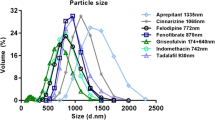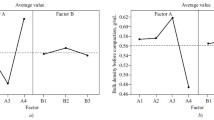Abstract
Acid neutralizing capacity (ANC) of antacids is an important indicator of the efficacy of such products. The purpose of this study is to evaluate the effect of pharmaceutical properties on the ANC of antacid oral suspensions. Fifteen antacid oral suspensions randomly sourced from different manufacturers and coded A1-A15 were assessed using ANC, raft formation, sedimentation profiles, ease of re-dispersibility, density, alkalinity, particle size, viscosity and rheological patterns. The effects of the pharmaceutical properties were discussed on the ANC and conclusions drawn. The results showed that ten (66.67 %) of the samples passed the ANC test among which 5 (83.33 %) were non-sedimenting highly viscous suspensions. One sample (A5) presented raft formation. Sedimentation volume reduces with time, ease of re-dispersibility was in seconds and the density range for all samples was 1.06–1.26 g/mL. The particle sizes of the antacid oral suspensions were within the range for coarse dispersions. The viscosity values ranged from 39.33 ± 1.53 to 2508 ± 24.33 cp. The rheogram of A3 shows a Newtonian flow with a regression coefficient of 0.999 and it had the least ANC. Other samples present non-Newtonian flow in a pseudoplastic pattern. Comparison of the viscosity of samples with ANC shows no direct relationship between the two variables although most samples with low viscosity failed the ANC test. The acid neutralizing capacity of the antacid oral suspensions is influenced by the dynamics of different parameters including type of active pharmaceutical ingredient, sedimentation profile, viscosity and overall rheology of the suspension.



Similar content being viewed by others
References
Ajala TO, Oreagba MI, Odeku OA (2014) The pharmaceutical equivalence and stability of multisource metronidazole suspensions. Afr J Med Med Sci 43:139–148
Ansel HC, Allen LV, Popovich NG (eds) (1999) Pharmaceutical dosage forms and drug delivery systems, 7th edn. Lippincott Williams and Wilkins, Philadelphia, 64–67, 347–348
Ashford M (2002) Bioavailability—physicochemical and dosage form factors. In Aulton ME (ed) Pharmaceutics. The science of dosage form design, 2nd edn. Churchill Livingstone, Edinburgh, pp 244–245
Billany MR (1998) Suspensions and emulsions. In: Aulton ME (ed) Pharmaceutics: the science of dosage form design, 2nd edn. Churchill Livingstone, London, pp 334–358
British Pharmacopoea (2005). H.M.S.O. London vol III CD
British Pharmacopoeia (2012) Volume III: formulated preparations: specific monographs, compound alginate antacid oral suspension, p 21
Brown LF, Wilson DE (1999) Gastro-duodenal ulcers: causes, diagnosis, prevention and treatment. Compr Ther 25(1):30–38
DeVault KR, Castell DO (2005) Updated guidelines for the diagnosis and treatment of gastroesophageal reflux disease. Am J Gastroenterol 100:190–200
Dimaline R, Varro A (2007) Attack and defence in the gastric epithelium-a delicate balance. Exp Physiol 92(4):591–601
Inadomi JE, Pandolfi JE, Sabesin SM (2007) Update on the diagnostic evaluation and medical management of reflux esophagitis. Gastroenterol Hepatol 10(suppl 30):4–12
Kumar P, Clark M (2000) Peptic ulcer disease: Gastrointestinal disease. In: Clinical medicine, vol 6, 5th edn. Elsevier Saunders, London pp 272–273
Kumar S, Gupta SK (2012) Natural polymers, gums and mucilages as excipients in drug delivery. Polym Med 42(3–4):191–197
Leong RW (2009) Differences in peptic ulcer between the East and the West. Gastroenterol Clin N Am 38(2):363–379
Liebow C (2006) The stomach’s work. In: Stomach. Accessed 4 April 2014, from World Book Online Reference Center database: http://www.worldbookonline.com/wb/Article?id=ar534380&st=antacid
Mandel KG, Daggy BP, Brodie DA (2000) Review article: alginate-raft formulations in the treatment of heartburn an acid reflux. Aliment Pharmacol Ther 14(6):669–690
Martin A (2001) Suspensions. In: Physical pharmacy. 4th edn, Lippincott William & Wilkins, Baltimore, pp 480–481
Miskovitz PMD, Betancourt M (2005) Treating reflux disease. In: The doctor’s guide to gastrointestinal health: preventing and treating acid reflux, ulcers, irritable bowel syndrome, diverticulitis, celiac disease, colon cancer, pancreatitis, cirrhosis, hernias and more, Wiley, Hoboken, p 55
Moayyedi P, Talley NJ (2006) Gastroesophageal reflux disease. Lancet 367:2086–2100
Mycek MJ, Harvey RA, Champe PC (2000) Gastrointestinal and antiemetic drugs. In: Harvey RA, Champe PC (eds) Lippincott’s illustrated reviews: pharmacology, 2nd edn. Lippincott William and Wilkin, Philadelphia, pp 235–246
Nguyen L, Birk J (2009) Current and prospective pharmacotherapies in gastroesophageal reflux disease. Clin Med 2009(1):983–997
Soll AH (1996) Medical treatment of peptic ulcer disease: practice guidelines. J Am Med Assoc 275:622–629
Swarbrick J, Rubino JT, Rubino OP (2000) Coarse dispersions. In: Gennaro AR (ed) Remington: the science and practice of pharmacy, 20th edn. Lippincott Williams & Wilkins, Pennsylvania, pp 317–322
Tulassay Z, Herszényi L (2010) Gastric mucosal defense and cytoprotection. Best Pract Res Clin Gastroenterol 24(2):99–108
Walker P, Wood E (2003) The temporary storage tank. In: The digestive system. Lucent Books, Farmington Mills, pp15–16
Wilson JD (1992) Disorders of the gastrointestinal system: Peptic ulcer and gastritis. Harrison’s Principles of Internal Medicine, vol 9, 12th edn. The Mcgraw Hill Companies, Medical Publishing Division, London, pp 1222–1248
Yoshida CM, Kotz D (2004) Try an over-the-counter heartburn remedy. In: No more digestive problems. Bantam Books, New York, pp 105–106, 214
Yuan Y, Padol IT, Hunt RH (2006) Peptic ulcer disease today. Nat Clin Pract Gastroenterol Hepatol 3(2):80–89
Acknowledgments
This article does not contain any studies with human and animal subjects performed by any of the authors. And all authors (T.O. Ajala, B.O. Silva) declare that they have no conflict of interest.
Author information
Authors and Affiliations
Corresponding author
Rights and permissions
About this article
Cite this article
Ajala, T.O., Silva, B.O. The effect of pharmaceutical properties on the acid neutralizing capacity of antacid oral suspensions. Journal of Pharmaceutical Investigation 45, 433–439 (2015). https://doi.org/10.1007/s40005-015-0188-x
Received:
Revised:
Accepted:
Published:
Issue Date:
DOI: https://doi.org/10.1007/s40005-015-0188-x




